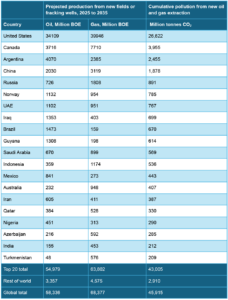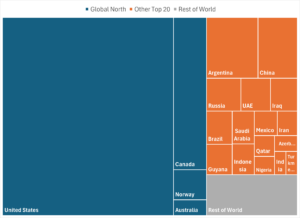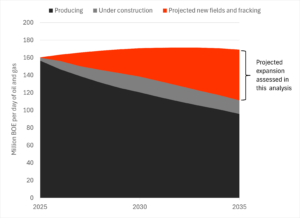
Planet Wreckers: Top Global North Countries Responsible for nearly 70% of projected new oil and gas expansion to 2035
Four Global North countries – the United States, Canada, Norway, and Australia – are responsible for nearly 70% of projected new oil and gas expansion from 2025 to 2035. If this oil and gas expansion is allowed to proceed, it would lock in climate chaos and an unlivable future.
Key findings
- At COP28, all countries committed to transitioning away from fossil fuels in an equitable manner, which implies that the richest countries with the highest capacity to do so should phase out fossil fuels first. OCI analysis shows this commitment is largely being ignored: oil and gas expansion is continuing across the board.
- Not only are Global North countries continuing to open new oil and gas fields, but only four of them (United States, Canada, Norway, and Australia) are responsible for nearly 70% of projected carbon-dioxide (CO2) pollution from new oil and gas fields and fracking wells between 2025 and 2035.
- New oil and gas development in these four countries over this time span could cause 32 billion tonnes (Gt) of carbon pollution, equivalent to three times the annual emissions of all the world’s coal power plants combined. [1]
- Due to continued expansion of fracking for shale, the United States (58%) and Canada (9%) alone account for two-thirds of the carbon pollution threatened by new oil and gas drilling through to 2035, equivalent to 19% of the remaining global carbon budget for a 1-in-2 chance of limiting temperature rise to 1.5 degrees Celsius (°C). [2]
- Brazil, the COP30 host, is among the 10 largest expanders of oil and gas to 2035, with expansion plans that surpass those of Saudi Arabia.
- Globally, the new extraction comes on top of existing oil and gas fields and coal mines, which already contain more than 3.5 times more CO2 than what remains in the 1.5°C carbon budget. [3]
- Studies of equitable global oil and gas phaseout pathways show these wealthy oil and gas producing countries should be phasing out their production before 2035, in addition to paying the finance they owe to enable Global South countries to transition off of fossil fuels and pay for adaptation and loss and damage. [4]
- At COP30, countries must go further than the broad commitment to transition away from fossil fuels: they must adopt differentiated phaseout timelines for fossil fuel production and use, with rich countries committing to end fossil fuel extraction in the mid 2030s, and address the systemic barriers preventing developing countries from transitioning to renewable energy, including finance.
Table 1: Top 20 countries, ranked by carbon pollution from projected new oil and gas fields and fracking wells, 2025 to 2035 [5]

Source: Oil Change International analysis of data from the Rystad Energy UCube (May 2025). BOE = barrels of oil equivalent.
Figure 1: Proportional responsibility for projected oil and gas production from new fields and fracking wells by country, 2025 to 2035

Source: Oil Change International analysis of data from the Rystad Energy UCube (May 2025).
Context
At COP28 (2023), nations decided to transition away from fossil fuels in line with the 1.5 degrees Celsius (°C) threshold of the Paris Agreement. The transition will happen – but whether it will be equitable, at the scale needed and in time to avoid the worst of the climate crisis depends on countries actively planning for and financing this shift.
The science is crystal clear that any approval of new oil and gas development is incompatible with holding global temperature rise to 1.5 degrees Celsius. Existing extraction projects alone, without any further expansion, would cause carbon emissions more than 3.5 times the size of the remaining 1.5-degree carbon budget [6]. Thus, the majority of oil, gas, and coal in already producing and under construction extraction projects needs to stay in the ground in order to keep the 1.5°C global warming limit in reach. [7]
Planet Wreckers must phase out and pay up
A year and a half after the COP28 decision on fossil fuels, oil and gas expansion is continuing around the world, and, in some places, accelerating. But not all countries are equally responsible for this situation: Global North oil and gas producing countries, especially the United States, are by far the worst culprits for projected oil and gas expansion to 2035, the date at which the new round of Nationally Determined Contributions are meant to end. This is based on the amount of production expected to come from new oil and gas fields and fracking wells between 2025 and 2035 (see Methodology). If these countries were committed to carrying out the equitable transition they signed up for in Dubai, they would not only end expansion, but also phase out existing production fastest and provide their fair share of climate finance on fair terms.
Countries like the U.S., Canada, Norway, and Australia continue to stand out as the most egregious Global North “Planet Wreckers.” They are among the richest in the Global North with the greatest economic capacity to phase out extraction, and yet are still approving and enabling new oil and gas projects to increase and/or maintain their own production. This is despite their historic responsibility for driving the climate crisis and having the means to mobilise trillions of dollars every year to support Global South countries to transition to renewable energy and support other public goods. Instead, they are the rogue actors on the global stage when it comes to climate change.
At COP30, countries have an opportunity to course correct by working together to operationalize a just and equitable transition away from fossil fuels. Equity is not just a buzzword: It is a foundational requirement to accelerate the transition. Unless and until the richest countries commit to ending fossil fuel production and use first, and demonstrate they are adopting concrete plans to do so, while also delivering adequate climate finance on fair terms, global calls for fossil fuel phaseout will ring hollow to developing countries that are struggling to meet development, energy access, and climate resilience needs.
While inaction by rich Global North countries is unacceptable, climate arithmetics and the inevitable end of the fossil fuel era mean that all oil and gas producing nations need to accelerate their exit from fossil fuels. It is therefore essential that COP30 deliver a collective agreement on equitable phaseout dates for fossil fuel production and use, as the logical next step to implement the COP28 decision.
Trump administration charging forward with increased oil and gas production despite weakening demand
The data shows that the United States once again deserves the title of Planet-Wrecker-in-Chief, because it accounts for the majority (58%) of the carbon pollution that would be created by new oil and gas between now and 2035, equivalent to over 16% of the remaining 1.5°C global carbon budget [8]. In the U.S. (as well as Canada and Argentina), nearly all expansion tallied in this analysis comes from projected new fracking wells for shale production.
The Trump administration is seeking to accelerate this expansion by using U.S. oil and gas exports as a trade war battering ram and fast-tracking approval of environmentally harmful new export infrastructure. Despite reports that some shale producers are scaling back production because of falling oil prices and uncertainty, the overall picture in the U.S. is one of strong governmental support for rapid expansion of fossil fuel production.
While the United States doubles down on its fossil fuel addiction, countries must resist pressure to sign onto long-term LNG contracts with the US, which would lock the world in fossil-fueled climate chaos and spread toxic pollution in the communities near gas infrastructure. The recent deregulation of U.S. gas infrastructure and gutting of environmental laws will only make these impacts more severe for communities, and may increase the already significant gap between the actual emissions intensity of U.S. oil and gas and industry claims. However, states and local governments have the power to lead a transition away from fossil fuels.
Brazil and Australia: from fossil fueled contradictions to the conveners of a global conversation on equitable phaseout at COP30 and COP31?
Brazil, the host of this year’s UN climate talks, is actively pursuing fossil fuel expansion, ranking even higher in projected CO2 emissions from oil and gas expansion to 2035 than Saudi Arabia. Previous OCI research has shown that Brazil ranks third globally in terms of oil and gas expansion approved in the year after the COP28 decision to transition away from fossil fuels and is planning to rapidly increase its production of oil and gas in the next 5 to 10 years. [9]
This policy of increased fossil fuel production, boosted by the dismantling of environmental licensing legislation in Congress, sets a detrimental example at a time when Brazil aspires to be seen as a global climate leader. However, Brazil exemplifies the difficulties that emerging economies with oil and gas reserves face when trying to balance poverty eradication, industrialization, and climate goals. COP30 is therefore an opportunity for Brazil to initiate an honest global conversation on what these countries need from the global climate process in order to be able to transition, and on how rich countries must lead the way in a full, fair, and funded fossil fuel phaseout. As such, it could enable conditions for the Global South to transition while ensuring prosperity and development.
Meanwhile, Australia, as one of the worst Global North Planet Wreckers, is currently making a bid to host COP31 in 2026. Yet just days before the opening of the 2025 Bonn intersessional meetings, where it hoped to secure the hosting rights, Australia signalled they intend to approve a proposal from Woodside to extend the life of its North West Shelf gas processing facility to 2070 – part of a mega-project poised to be the most polluting proposed fossil fuel development in the southern hemisphere. This extension unlocks the possibility of further gas extraction from the offshore Browse gas basin – which could drive significantly greater expansion than is covered by this analysis and its 2035 timeframe. Over its 50-year life, the project would lead to an estimated 4.4 billion tonnes (gigatonnes) of climate pollution.
This approval has rightly led to criticism highlighting the two-faced actions of pushing for a COP that on the surface prioritises collaboration with Pacific Island Nations, while greenlighting projects that risk the lives and livelihoods of Pacific Island communities.
Recommendations
As world leaders gather in Bonn for June climate meetings and on the road to COP30 in Bélem, negotiators and countries must support:
- A COP decision calling on countries to adopt differentiated timelines in phasing out fossil fuel production and use on the basis of their respective wealth, capacities, and historical responsibility, as well as an immediate end to new fossil fuel projects.
- Commitments to fair climate finance and financial reform, including through article 2.1(c) negotiations, the Baku to Belem roadmap, and Financing for Development 4 to:
- Fairly phase out all forms of fossil fuel support, including subsidies, public finance and investments by State-Owned Enterprises (SOEs), with developed countries taking the lead;
- Support the democratic financial architecture reform needed to ensure the fiscal space and economic sovereignty needed to pay for fair fossil fuel phase out;
- Explicitly exclude false solutions, carbon credits and commercial loans from climate finance; and
- Adopt a reporting methodology and targets that prioritize grants and highly concessional loans;
- A Just Transition decision that directs climate finance to just transition policies, and coordinates all the actors of Just Transition finance through the launch of the Belem Action Mechanism for Just Transition at COP30. This will enable just transitions, including in the energy sectors through: coordinating fragmented initiatives across multilateral actors; building the space for workers and communities to co-decide how we do climate action; and recognising transitioning away from fossil fuels as one of the challenges it must address.
Methodology:
The Rystad Energy UCube database is our source for projected volumes of oil and gas production from new oil and gas fields and fracking wells by country between 2025 and 2035. Oil volumes include condensate and natural gas liquids. We calculate the CO2 emissions that would result globally from burning the oil and gas produced from new fields and fracking wells from 2025 to 2035 by applying CO2 emissions factors of 0.421 tCO2/bbl of oil and condensate, 0.235 tCO2/bbl of natural gas liquids, and 54.7 tCO2/Mmcf of gas to the oil and gas volumes taken from Rystad. These emissions factors are derived from the Intergovernmental Panel on Climate Change. [10]
The UCube is a commercial, asset-based database and model that contains data on reserves, production, economics, and valuation for every oil and gas field, resource discovery, and exploration license globally. The production projections used in this analysis are current to the May 2025 UCube update and sensitive to future changes in government policies and oil and gas markets. Rystad’s base oil price case as of May 2025 assumes a benchmark Brent oil price of USD 70/bbl long term (real $2025). If prices remain lower than in Rystad’s base case for an extended period, Rystad’s modeling suggests total production from new supply would likely be less, but the dominance of the U.S. and Canada in bringing new supply online would remain.
Oil and gas expansion, or new supply, is defined as development of new oil and gas fields or fracking wells that are not yet producing or under construction as of May 2025. The oil and gas in these projects are not yet committed to extraction through a final investment decision and/or still require permits or licenses from governments to enable their extraction. Thus, these potential sources of new pollution can still be stopped, their reserves kept in the ground. The
Oil and gas expansion, or new supply, is defined as development of new oil and gas fields or fracking wells that are not yet producing or under construction as of May 2025. The oil and gas in these projects are not yet committed to extraction through a final investment decision and/or still require permits or licenses from governments to enable their extraction. Thus, these potential sources of new pollution can still be stopped, their reserves kept in the ground. The figure below shows projected global oil and gas production from 2025 to 2035 by current stage of development – the red area in this figure represents the expansion assessed in this analysis.
Figure 2: Projected global oil and gas extraction with and without new expansion, 2025 to 2035

Source: Oil Change International analysis of data from the Rystad Energy UCube (May 2025). Boe = barrels of oil equivalent
Endnotes:
- As of January 2025, Global Energy Monitor estimates that operating coal power stations cause 10.4 Gt CO2 of annual emissions.
- Based on scientists’ most updated methodologies, the remaining carbon budget for a 50% chance of limiting global temperature rise to 1.5°C is estimated at just 160 Gt CO2 from 1 January 2025. This is based on adjusting the Forster et al (2024) estimate of 200 Gt CO2 from 1 January 2024 by subtracting 2024 CO2 emissions as estimated in Friedlingstein et al (2025).
- UNEP showed in 2023 that existing extraction would cause emissions 3.5 times the size of the remaining 1.5°C budget, which has now shrunk further. United Nations Environment Programme, Emissions Gap Report 2023: Broken Record – Temperatures hit new highs, yet world fails to cut emissions (again), 2023, https://www.unep.org/resources/emissions-gap-report-2023, at pages 34 to 35.
- Civil Society Equity Review, An Equitable Phase Out of Fossil Fuel Extraction, 2023, https://www.equityreview.org/extraction-equity-2023; Dan Calverley and Kevin Anderson, Phaseout Pathways for Fossil Fuel Production Within Paris-compliant Carbon Budgets, 2022, https://pure.manchester.ac.uk/ws/portalfiles/portal/213256008/Tyndall_Production_Phaseout_Report_final_text_3_.pdf.
- As this data focuses on projected new oil and gas development only (see Methodology), these data do not reflect countries’ cumulative projected oil and gas production over this time period, or historical responsibility. Countries in this list have vastly differing historical and ongoing cumulative contributions to the climate crisis. For example, Guyana is an important carbon sink and its oil is largely being exported to be burned in other countries, which is emblematic of a push by U.S. and European oil and gas companies to drive expansion into new entrant countries in the Global South.
- United Nations Environment Programme, Emissions Gap Report 2023: Broken Record – Temperatures hit new highs, yet world fails to cut emissions (again), 2023, https://www.unep.org/resources/emissions-gap-report-2023, at pages 34 to 35.
- “Sky’s Limit Data Update: Shut Down 60% of Existing Fossil Fuel Extraction to Keep 1.5°C in Reach,” Oil Change International, 2023, https://oilchange.org/publications/skys-limit-data-update-shut-down-60-of-existing-fossil-fuel-extraction-to-keep-1-5c-in-reach/.
- Based on estimates of a remaining 1.5°C budget of 160 Gt CO2 from 1 January 2025, as explained in footnote 2.
- Oil Change International, The COP Troika – fossil fuel champions or guardians of 1.5°C?, 2024,
https://oilchange.org/publications/the-cop-troika-fossil-fuel-champions-or-guardians-of-1-5c/ - 2006 IPCC Guidelines for National Greenhouse Gas Inventories, Volume 2 (Energy), Chapter 1 (Introduction), Table 1.3, https://www.ipcc-nggip.iges.or.jp/public/2006gl/index.html.
